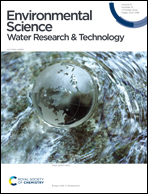Surface modification of carbon catalysts for efficient production of H2O2 in bioelectrochemical systems†
Abstract
Bioelectrochemical systems (BESs) can harvest electrical energy and produce H2O2 simultaneously through oxygen reduction reaction on a cathode. In this study, a carbon-based electrode was modified using physico/chemical methods to enhance H2O2 production. In addition, the performance of the developed cathodes was evaluated in continuous-flow BESs. Carbon catalysts were obtained through different treatments, namely heat treatment (CB-Heat), acid treatment (CB-Acid), and simultaneous heat and acid treatment (CB-H + A); among these methods, the simultaneous heat and acid treatment was particularly effective in improving the H2O2 yields. Abiotic half-cell tests showed that CB-H + A was superior because the carbon powder had a large Brunauer–Emmett–Teller surface area (172.3 m2 g−1), pore volumes (micropore 0.0386 cm3 g−1, mesopore 0.3100 cm3 g−1, and macropore 0.0018 cm3 g−1), and oxygen functional groups (O atomic percentage 4.79%). Rotating ring-disk electrode results also showed that CB-H + A had the highest H2O2 selectivity (max 68.3%). In the continuous-flow BESs, all the developed carbon catalysts demonstrated stable current generation. The catalyst with the highest H2O2 production was CB-H + A, which produced about 260 ± 5 mg L−1 of H2O2, followed by CB-Heat (211.1 ± 4.1 mg L−1) and CB-Acid (126.8 ± 5.5 mg L−1), and the production concentration was stable over the course of the continuous operation periods. In addition, the maximum H2O2 conversion efficiency (78.9%) also had the highest value compared to the other catalysts.



 Please wait while we load your content...
Please wait while we load your content...